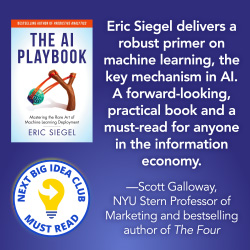Call for Contributions and Editorial Policy
We are currently accepting editorial submissions for consideration.
Why publish in the Machine Learning Times?
As the field of predictive analytics continues to quickly grow — across industry verticals and across line-of-business application areas — so does the demand for substantive content: Case studies, thought leadership, and technical insight.
Gain highly visible exposure. Widen your reputation as an expert and strengthen your company’s reputation as a leader in predictive analytics by publishing in the Machine Learning Times.
The Machine Learning Times is the predictive analytics professionals’ premier resource, delivering timely, relevant industry-leading content: articles, videos, events, white papers, and community. The only full-scale content portal devoted exclusively to predictive analytics and its commercial deployment, the Machine Learning Times has become a standard must-read. Professionals at large are compelled to sign up for the email newsletter, and to visit the website often. More information about The Machine Learning Times.
Editorial Guidelines
The Machine Learning Times has a quickly growing subscription base of 14,000. The property targets both readers who are less technical (newcomers and management-level), as well as hands-on analytics practitioners.
Original content. Our leading, highlighted content items are original. These items are listed first in our periodic email newsletter, appear front and center on the Machine Learning Times’ homepage, and are demarcated as “original content.” To qualify as original content, your article or other content item must be original work that has not been published elsewhere. If you are considering publishing it on your own personal blog, you may do so only two or more weeks after its publication in The Machine Learning Times, with linked text “Originally published in The Machine Learning Times” linking back to your PAW article. You agree not to authorize the publication of the content as “original” in any other property, and and that the Machine Learning Times’ URL for your piece be the de facto reference for any citation or excerpting of your content item.
Curated content. As an alternative option to original content, if you have published an article elsewhere and you would like the Machine Learning Times to consider including or excerpting it as a non-original, curated content item (with a link to its original source), please contact us to bring it to our attention for consideration.
Vendor-neutral content. All content published in the Machine Learning Times must be vendor-neutral. In particular, it must present substantive content such that the reader could implement or otherwise benefit from what is covered without necessarily buying any particular product or professional service. Although vendors may be named if relevant, your item’s headline itself may not name an analytics software vendor or tool, other than non-promotional free software tools.
Choice of topic. Start by asking yourself, what are the biggest wins we have achieved via predictive analytics? In the pursuit of what application (marketing, credit scoring, marketing, healthcare, etc.)? Along the way, what were the biggest lessons we learned or methods established that would be of most interest to my colleagues at large (across industries, where applicable)? Three example types of articles are: 1) Concrete, specific case studies, 2) Specific how-to or first-steps instructions/guidelines for readers to follow, or 3) A clear, strong conceptual or thought-leadership piece that would present a novel insight for predictive analytics professionals and would very much catch their attention.
Article length. While shorter length articles such as 800 words are often the most feasible for many busy readers – and help enforce the writer to be more focused in concisely delivering only the strongest points and take-aways – The Machine Learning Times has no specific enforced word limit. Longer articles must be compelling throughout in order to carry the reader along all the way, and must be well-structured, preferably in part by way of clearly worded section headers.
Author bio and the author’s affiliation. The tail end of your submitted article should include a short, all-italics bio. If your affiliation is an analytics vendor, or an organization without a generally-recognizable name, include a sentence or two on the what your organization does. This provides important contextual information for both the editor and the eventual reader, especially if there may be any question as to whether your organization sells the approach espoused in your writing. Any information you wish to provide about your affiliation must be within the context of your bio; “about the company” paragraphs are not permitted.
For inquiries, or to submit content for consideration fill out the form below:
Permission to Reuse Content. If you see something on Machine Learning Times that you would like to reuse — for your company newsletter, blog, your own website, a course you’re teaching — we’re happy to share that with you. Please be sure to reference Machine Learning Times and provide a link to the appropriate URL on our site.






